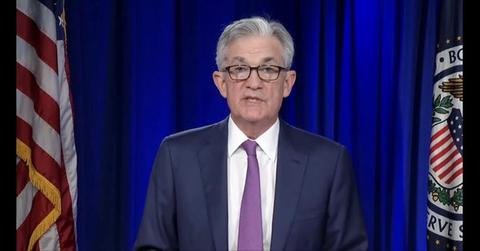Fed Policy Update and What Jerome Powell Said After the Meeting
The Federal Reserve has concluded its two-day meeting. What was the Fed policy update and what did Jerome Powell say after the meeting?
June 17 2021, Published 9:12 a.m. ET

On June 16, the Federal Reserve concluded its two-day meeting. The last Fed meeting was held in March 2021. The inflation expectations changed considerably between the last meeting and the current one. Investors were watching Fed Chair Jerome Powell's comments closely for expectations regarding future interest rate rises. Due to widespread vaccination efforts, the economy has come out of the depths of the COVID-19 pandemic. Therefore, it was important to watch how the Fed sees the current economic position. What was the Fed policy update and what did Jerome Powell say after the meeting?
Fed has a dual mandate of maximizing employment while maintaining stable prices. The Fed also acknowledged the role of vaccinations in bringing the economy back on track. However, Powell cautioned that we still aren't out of the woods at this point.
Interest rates unchanged—hikes seen sooner now
As was widely expected, the committee left the interest rates unchanged near-zero levels as they have been since March 2020. However, the market moving statement that came from Powell was that the committee has raised its inflation expectations for 2021 and has brought forward the time frame for the next interest rate raises. The Fed raised its headline inflation expectation to 3.4 percent, which is one percentage point higher than its March projection. This change is likely due to the biggest rise in consumer prices in about 13 years for two consecutive months. The committee continues to see the inflation pressures as “transitory.”

In March, the Fed saw no rate increases until at least 2024. In the Fed's latest meeting, it indicated that the rate hikes could come as soon as 2023. In fact, according to the Fed’s dot plot, there could be two rate hikes in 2023, which could see interest rates moving to 0.6 percent by the end of 2023 from the current 0.1 percent.
Stock markets declined on Powell’s comments
Powell’s comments moved the markets. Stock markets fell after the Fed released its projections. The S&P 500 closed down by 0.5 percent, while the Dow Jones Industrial Average Index tumbled by 0.8 percent. A higher interest rate environment implies higher borrowing costs for companies. A higher discount rate reduced the value of their future cash flows. Higher interest rates are usually taken by markets negatively even though they are coming on the heels of a stronger economy and higher demand.
Powell sounded optimistic on the economic outlook
Powell sounded optimistic about the economic outlook. The committee didn't mention when it would start tapering its bond purchases, which it is currently making to the tune of at least $120 billion on a monthly basis. The committee discussed bond purchases at the meeting. During depressed market conditions, bond purchases are carried out to stoke demand. However, they are phased out as demand shows signs of an uptick, which is currently happening.
How to position yourself for change in the Fed’s tone.
The Fed tries to be very cautious while choosing its phrases so that it doesn't have a market-moving impact. However, the current change in the Fed’s tone from just a few months ago could signal an upcoming policy shift. Paul Tudor Jones already said that if the Fed keeps on treating the high inflation rates with nonchalance, he will invest more in commodities, cryptocurrencies, and gold.
Investors who are reassessing their portfolios in light of the Fed’s latest comments could also invest in these assets. In inflationary price scenarios, real assets usually do well. Gold is considered an inflation hedge. While gold prices and interest rates are inversely related, high inflation rates could mean negative real interest rates. This should be good for gold prices since its demand spikes in a near-zero or negative real interest rate environment. Bitcoin and other cryptos have emerged as a new asset class, due to their decentralized nature, to hedge your portfolio from inflationary pressures.
